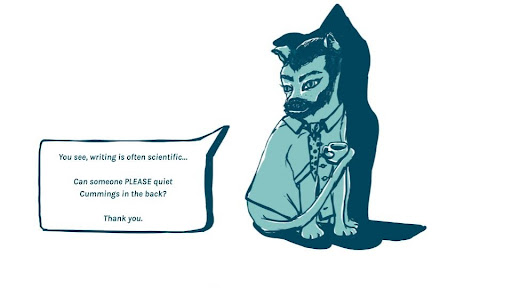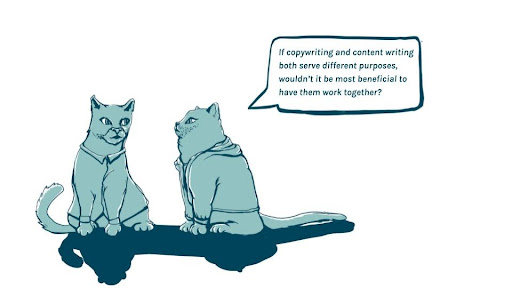Open up your books to page 12, kids. Today we’re learning about the scientific method. The scientific method will get you places, real places.
I know, I know, you’re a writer…what the heck are you doing in a blog post about the scientific method? Well, to that, I just ask you to be patient. This is an experiment, you see. It’s all about the journey.
As a writer, you’re most likely filled with questions—how long has this coffee been sitting out on my desk? Did my cat stick its paw in it? Would it be incredibly uncouth to take a sip even if he had?
Nevermind.
Back to your question, I believe I have it right here: what’s the difference between copywriting vs content writing? Well, generally, content writing informs, while copywriting sells. However, both types can be champions in the marketing world.
But, to answer your question properly, we’ll need to implement the scientific method.
Understanding Copywriting vs Content Writing with the Scientific Method

No matter what you’re writing, it often requires a scientific approach. In other words, there must be a rhyme and a reason propelling it forward, especially when writing for the consumer market.
So, in understanding the difference between the two forms of writing, why not enlist the help of science’s most credible companion, the scientific method?
Now, when understanding the scientific method, it’s important to understand its purpose. The scientific method was developed to help the doers and thinkers of the world answer their many questions. How? By creating a system in which they could collect measurable, fact-based data.
The scientific method is composed of six parts:
- Observation and questioning
- Research
- Hypothesis
- Experimentation
- Analysis
- Conclusion and communication, i.e, sharing the results of your findings with others
Pretty simple, right? Now, let’s have you give it a try.
#1 The Question: What’s the Difference Between Copywriting vs Content Writing?
So, we’re trying to identify the differences between content writing vs copywriting, correct? Well, that’s our question. Simple, easy. You’re getting the hang of this.
Now, take it one step further.
- What purpose does each type of writing serve?
- How are they approached?
- What is their intent?
- And how can both copywriting and content writing be expertly executed?
Let’s explore.
#2 The Research: Copywriting vs Content Writing
As you know, the next step of the scientific method is research. Let’s explore what we’ve already discovered about these two subjects, and what they mean for us as writers.
What is Copywriting?
The origin of copywriting dates back to the country’s first newspapers—circa 1784. Back in the days of newspaper peddlers and newsies, there was also the copywriter. Holed up somewhere dark and dingy, copywriters would write to sell.
In those days, copywriters sold religious magazines, encyclopedias, beers—often painting their calls on brochures and posters with feathers and ink.
In fact, copywriting was a lot like content writing—it provided the facts. A 1913 print advertisement for the Encyclopedia Britannica boasted its 28,150 pages, 44,000,000 words of text, and strong, opaque Indian paper. That was it.
However, since the days of feathers and ink, the purpose of copywriting has rapidly expanded. With credit on the rise and more and more products on the market, copywriting evolved into the practice of telling buyers why they should buy their product amongst the mountain of similar products available on the market.
Essentially, copywriting’s purpose is to:
- Inform the public of a product
- Persuade the public of the product’s benefits
- Sell the product to the public
Then came social media. Social media opened up a whole new world for copywriters. Now, in addition to selling a product, copywriters must also sell a brand and curate an identity that attests to certain value propositions, such as sustainability, body positivity, or just a general air of coolness.
In addition to reflecting a brand’s products and services, an effective brand identity also curates a loyal customer base.
To that end, copywriting is the tool of the salesman or brand manager. It’s the most critical aspect of a marketing or advertising campaign and aims to get consumers to buy a product or subscribe to an ideology solely through the power of words—and with urgency, too.
What is Content Writing?
Content writing has a different sort of history, one that isn’t so easily traced back to the rise of mass print production. In fact, content writing hardly has anything to do with print at all.
The art of content writing arose alongside the onset of the internet. As technology became more advanced and both individuals and companies began developing websites, content writers served to provide specialized and relevant content to digital platforms.
The purpose of content writing is to inform and educate readers by providing them with valuable information about a brand-specific subject or topic. But it can also be used as a soft sell.
Unlike copywriting, content writing doesn’t encourage readers to flock to shops and stores in search of the newest product. When using content writing as a marketing tool, it can subtly foster brand loyalty and awareness, and maybe even plant a few seeds about offerings, but it rarely promotes anything directly.
Instead, content writing helps brands and individuals cultivate a brand identity and establish themselves as trusted sources.
Content writing can include:
- Blog posts
- Social media posts
- Website content
- Newsletters and emails
- Infographics
- Whitepapers
- Case studies
- eBooks
To that end, when done properly, content writing can also help to curate a loyal consumer following.
#3 The Hypothesis: Make an Assumption
Now, with what you know about copywriting and content writing, what hypothesis, or assumption, can you make to help test and better understand the differences between these two forms of marketing?
Perhaps, content writing is a far superior tool when cultivating long-term customer relationships and loyalty. Or maybe, if you’re looking to compel a consumer to buy your product quickly, a copywriting strategy may better serve your objectives.
Now, these are assumptions, not facts, and you’re free to assume whatever you’d like about the worlds of content writing and copywriting. However, for this article’s sake, let’s go with the second assumption:
If you use copywriting, then you can sell your product more effectively and efficiently.
#4 The Test: A Copywriting Experiment
As with all experiments, we need a control—something that remains unaffected. In this case, let’s make the control a children’s toy. Measuring in at four inches high, this tiny figurine is something of a superhero—red cape, blue boots, and a six-pack to match.
This superhero has to do all the heavy lifting itself—there’s no marketing team or copywriter peddling its assets. It goes directly from the toy maker’s shop to the store shelves, relying solely on a child’s glance and grabby hands to make a sale. Its name? Superhero Action Figure.
Now, enter the test subject. Also measuring four inches high, this superhero model is basically the same—red cape, blue boots, and a jarring six-pack. Except this toy is fueled by the power of copywriting. Its name? Captain Blaze: High-Voltage Crusador of Justice.
Spinning their wheels day and night, Captain Blaze’s marketing team conjures up action-packed TV commercials, Captain Blaze stunt shows, and red-hot copy that’s stamped across social media, toy store windows, and movie theater popcorn bags.
When children enter the toy store, they flock to Captain Blaze’s fire-tinged packaging and sweep it off the shelves, leaving Superhero Action Figure in the dust.
Maybe a few kids in search of Captain Blaze will settle for Superhero Action Figure once they realize it’s all that remains. But, you certainly won’t see children begging their parents for it.
Why?
Well, that’s the power of copywriting—it lights a fire beneath consumers’ feet, informing them of a hot new product and compelling them to buy, buy, buy.
#5 The Analysis: Drawing Conclusions
Now, this experiment implicates that copywriting may be the best tool for advertising products and emptying shelves, but is it the best tool for building customer relationships and trust in your brand? Sometimes, but not always.
As mentioned, content writing, rather than copywriting, can help develop a brand identity and cultivate trust. Good content writing can establish yourself or your brand as an authority of your domain, be it herbal supplements or barnyard-themed reading lamps.
But, the biggest difference between copywriting and content writing, specifically within the marketing sphere, is the purpose they serve:
- Copywriting – Copywriting is promotional and serves to generate interest in a product, service, or ideology, and compel consumers to buy or subscribe to that product, service, or ideology. Copywriters produce brochures, jingles, web copy, emails, blogs posts, and press releases.
- Content writing – Content writing primarily serves to inform readers about a niche subject pertaining to brand identity. It can also be used to share opinions, cultivate discussions, or even persuade readers. But ultimately, it aims to help build capital and trust.
#6 The Conclusion: Sharing the Results

Based on our meticulous use of the scientific method, it’s logical to make another hypothesis: A combination of both copywriting and content writing can propel a marketing strategy to new heights.
While copywriting can make all the sparkly appearances, waving at fans from billboards and TV ads, content writing chugs away in the background, setting the foundation for long-term, basket-filling, shelf-emptying success.
Copycat Copywriting: Your Content Writing x Copywriting Chemists
Now, this isn’t to say you should pick up your pen and start scrawling just anything to get the word out about your offerings. Like the scientific approach, you must be meticulous, precise, methodical.
You must question your purpose, research the market, assume the worst (then the best), test your messaging, and analyze its influence until you reach a compelling copy-based conclusion that aligns with your values and objectives.
But what’s the key to unlocking truly compelling content? Words that pack a punch—and a few snacks for the road. In other words, engaging copywriting and viable content writing.
Plus a cat, or two.
At Copycat, we craft a purr-fect formula of copy-fueled messaging. But don’t take our word for it. Test our hypothesis with a piece of free content today.

